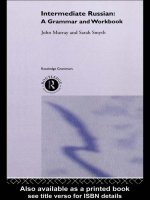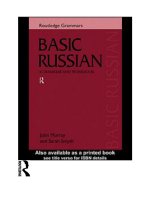biblical hebrew a text and workbook answer key
Bạn đang xem bản rút gọn của tài liệu. Xem và tải ngay bản đầy đủ của tài liệu tại đây (604.4 KB, 172 trang )
Answer Key to
Companion to the fully revised edition by
2
I dedicate this little book to my little
ֵאִלָיּוּה and ַחָוּה , who will, with any luck,
grow up to be able to point out all the errors I have made in writing it.
-bwm
3
Contents
Guide to the Answer Key 5
Lesson 2 6
Lesson 3 7
Lesson 4 8
Review and Drill 1 10
Lesson 5 12
Lesson 6 15
Lesson 7 19
Review and Drill 2 21
Lesson 8 24
Lesson 9 26
Lesson 10 28
Review and Drill 3 30
Lesson 11 33
Lesson 12 36
Review and Drill 4 38
The Verb 41
Lesson 13 43
Lesson 14 47
Lesson 15 52
Lesson 16 55
Lesson 17 58
Lesson 18 61
Lesson 19 63
Lesson 20 66
Lesson 21 68
Lesson 22 71
Lesson 23 73
Lesson 24 74
Lesson 25 76
Lesson 26 79
4
Review and Drill 5 81
Lesson 27 85
Lesson 28 88
Lesson 29 89
Lesson 30 92
Lesson 31 94
Lesson 32 97
Lesson 33 100
Lesson 34 101
Lesson 35 103
Lesson 36 106
Lesson 37 110
Lesson 38 113
Lesson 39 123
Lesson 40 126
Lesson 41 128
Lesson 42 131
Lesson 43 133
Lesson 44 135
Lesson 45 139
Lesson 46 143
Lesson 47 147
Lesson 48 149
Lesson 49 152
Lesson 50 153
Review and Drill 6 155
Lesson 51 162
Lesson 52 166
Lesson 53 168
Lesson 54 170
Lesson 55 171
5
Guide to the Answer Key
I’ve attempted to use a straightforward layout and style in writing this answer key
so that it can be used without needing any guide. I would, however, like to point
out two navigational features in the online file that users may find useful. To make
navigation of the Answer Key easier, the PDF file has been bookmarked with links
to each individual chapter. Clicking on the name of a chapter in the table of
contents will jump directly to that chapter as well.
Some of my tendencies, particularly in the translation sections, may need
clarification. I’ve used [square brackets] to indicate that the word enclosed is not
present in the Hebrew but supplied to make the English translation smoother. An
exception is for forms of the verb “to be” in the Hebrew noun sentence, since
they’re implied by Hebrew grammar even though they aren’t visible in the text.
I’ve also tended to give alternate translations when possible – occasionally ones
that make no sense at all in context – so students can start to think more flexibly
about the ambiguities in translation.
For the most part, I’ve tried to translate as literally as possible within the bounds of
English grammar. The results are often awkward, but – I hope – should help the
student see the correspondence of the Hebrew text to its translation even in the
most difficult constructions. I’ve also commented from time to time when there’s
an ambiguity or a point that could bear some more explanation. These
extrapolations are italicized to set them off clearly from the actual answers.
Finally, I would like to apologize in advance for any missing metegs, but in my
defense, they are (as you will quickly learn) frequently missing in actual Hebrew
texts anyway, especially when you really need one.
6
Lesson 2
2.2 What kind of dagesh is in the י ? Forte. It’s preceded by a full vowel (patah).
What kind of dagesh is in the
ב ? Forte – again, it’s preceded by patah.
2.3a What is the initial
ּ ַו ? The sign of the vav conversive construction.
2.3b What is the
י ? The subject pronoun. Form? Prefix. Person, Gender,
Number? 3rd masculine singular.
2.3d
Verb Root Stem Form Person/Gender/Number Special Features
ַוְיַּדֶבּר רבד
Pi`el prefix 3 m. sg. vav conversive
2.4 What is the relationship of God to the verb? Subject
2.5
לֶא
־
is a preposition meaning to
2.7
Verb Root Stem Form Person/Gender/Number Special Features
רֶמאֹיַּו רמא
Qal prefix 3 m. sg. vav conversive
2.8 Translate: and he said
2.10a
הוהי is the divine name: Yahweh, Adonai, the Lord
2.13C Translate:
1. And the Lord said to him:
2. And the Lord spoke to Moses and to Aaron.
3. And Moses said to Aaron:
4. The Lord is one.
7
Lesson 3
3.1 ּ ַו is the sign of the vav conversive, and י is a prefix pronoun.
3.2
Verb Root Stem Form Person/Gender/Number Special Features
ַוֵיֶּלְך ךלה
Qal prefix 3 m. sg. vav conversive
3.2a Translation
vav conversive = and (past tense verb)
3 m. sg. prefix = he (subject)
Qal = (basic meaning)
ךלה = go
Translation = and he went
3.3 The normal order of the Hebrew sentence is verb-subject.
So the first two
words of this lesson sentence are translated: and David went
3.4a What kind of dagesh is in the
שּׁ ? Forte, because the preceding vowel (hireq)
is full.
3.5 Translation of verse: And David went from there.
3.6C Translate:
1. And Abraham went.
2. And God spoke to Noah.
3. And he went to him.
4. And Isaac went from there.
5. And Solomon said:
8
Lesson 4
4.1a What does ו at the beginning of a word mean? and
4.2a Is there any indication of a change in the basic meaning of the root? No – the
verb is unaugmented. What do you call this stem? Qal
Verb Root Stem Form Person/Gender/Number Special Features
ַמָשׁע שׁעמ
Qal affix 3 m. sg.
4.3 How many letters are in
ְךֶלֶמַּה ? Five: ה, מ (doubled), ל, and ך.
What kind of dagesh is in the
מ? Forte. ֶמֶלְך means king. What is the
relationship of this word to the verb? It is the subject.
Translation: the king
4.5a
לֶא
־
means to
4.6 Translate: And the king did not listen to the people.
4.7 Fill in the prefix + vav conversive for the 3 m. sg. in the chart below:
Pi`el Qal
רבד רמא
ַוַדְיֶבּר רֶמאֹיַּו
Again, note the lack of dagesh in the
י of ַוַדְיֶבּר , even though it’s part of the sign
of the vav conversive, because shewa frequently makes dagesh forte disappear.
ַוְיַּדֶבּר would be fine as well.
4.8B Classify the verbs according to form and stem.
9
Form Stem
Prefix/vav conv. Affix Qal Pi`el
רֶמאֹיַּו רֶמאֹיַּו
ִנָסּה ִנָסּה
ַהאָב ַהאָב
ֲחַיַּוֹבשׁ ֲחַיַּוֹבשׁ
ַוַבְיַקּע ַוַבְיַקּע
ַוֵיֶּלְך ַוֵיֶּלְך
ֲעַיַּוֹרְך ֲעַיַּוֹרְך
ַוַדְיֶבּר ַוַדְיֶבּר
ִיּ ַוְשַׁלח ִיּ ַוְשַׁלח
ְי ַוַשַׁלּח ְי ַוַשַׁלּח
ַדָיע ַדָיע
ַשָׂחְך ַשָׂחְך
4.8D Translate:
1. And he did not listen to him.
2. David went.
3. The Lord did not speak.
4. The Lord spoke to the people.
5. A people went forth.
10
Review and Drill 1
II Hebrew to English
Verb forms:
ַוַדְיֶבּר ַוֵיֶּלְך אַָמר ִדֶבּר רֶמאֹיַּו ַמָשׁע ִיּ ַוְשַׁמע ָהַלְך
he went he heard he spoke and he went
and he heard and he said he said and he spoke
Verses:
1. The king did not see.
2. The man spoke.
3. And King Jehoiakim heard.
4. And the Lord did not speak.
5. And he sent … to King Hezekiah.
6. And Abram went as the Lord had spoken to him. Since the verb
רבד is referring to a past action in a subordinate clause, it’s ok
to make the translation smoother by translating it as a past
perfect (“had spoken”) instead of a simple past (“spoke”.)
7. And King Ahasuerus said:
8. King Artaxerxes gave to Ezra.
9. For the people heard.
10. And the Lord called to Moses.
11. And Abraham listened to Ephron.
12. And there Abram called. Don’t get confused and think this means
Abram gave a name to the place he was standing;
ָשׁם is an adverb, not a
noun.
11
III English to Hebrew
Verb forms:
he spoke –
ִדֶבּר
and he said –
רֶמאֹיַּו
and he heard –
ִיּ ַוְשַׁמע
he went –
ָהַלְך
he said –
אַָמר
and he walked –
ַוֵיֶּלְך
Sentences:
1.
ֹל אָהַלְךִמ ָשַּׁה םֶמֶּלְך
2. ֹל אָשַׁמעָה ָע םלֶא
־
ֱאֹלִהםי
3. ִיּ ַוְשַׁמעֱא ֹלִהםי
4. ַוַדְיֶבּרֱא ֹלִה םילֶא
־
אְַבָרָהם
5. רֶמאֹיַּוָדּ ִו דלֶא
־
ָהָעֲא םִנָד יִוד
6. ִיּ ַוְשַׁמ עֹמֶשׁ הלֶא
־
ָהָעם
7. אַָמרהוהי
8. ִדֶבַּה רֶמֶּלְךֵא ָלוי
12
Lesson 5
5.1a What kind of dagesh is in the ד ? Lene – it’s the first letter of the word, so it
can’t have a full vowel in the previous syllable (a previous word wouldn’t count!)
5.1b The verb root (
רבד) means speak. הוהי means the Lord.
5.2a Of our two nouns, which is definite?
הוהי Why? It’s a proper name.
5.3b
Verb Root Stem Form Person/Gender/Number Special Features
ָהָיה היה
Qal affix 3 m. sg.
5.4
לֶא means to
5.5 Translation of sentence: the word of the Lord, which came (was) to Hosea
5.6 Identify as definite or indefinite:
ַהְדָּבִרםי ָהִערי וֶּבֶגד
definite definite indefinite
(definite article) (def. art. with
compensatory lengthening)
אְַבָרָהם ַרְגָלוי ַמְלכּוֹ
definite definite definite
(proper noun) (3 m. sg. possessive (3 m.sg. poss.
pronoun) pron.)
ַהָמּוֹקם ֹצןא ַמֵצָּבה
definite indefinite indefinite
(def. art.)
13
ֵעָנ יוי ְשֵׁנְנ יָעָרוי ְוַהַנַּער
definite definite definite
(3 m.sg. poss. (construct chain, noun in (def. art.)
pron.) absolute is definite due to
3 m.sg. poss. pron.)
ֵשׁם ַהַמֲּאֶכֶלת ַהר
indefinite definite indefinite
(def. art.) (no, it doesn’t mean
“the resh”)
ַהֶשּׂה ָמוֹקם ַהיּוֹם
definite indefinite definite
(def. art.) (def. art.)
ֻסָלּם ֵשׁם
־
ַהָמּוֹקם ַהֶשֶּׁמשׁ
indefinite definite definite
(const. chain, definite (def. art.)
absolute – def. art.)
ֵבּ תיֱאֹלִהםי ָהאֶָרץ ַשַׁעַה רָשַּׁמםי
definite definite definite
(const. chain, definite (def. art. with (constr. chain, definite
absolute – proper noun) comp. lengthening) absolute – def. art.)
5.6C Translate:
1. the word that was/happened to Jeremiah. A smoother, less literal
translation would be “came” for
היה
2. And the Lord did not hear.
3. The word of the Lord was to him.
4. And he did not go.
14
5. The word of the Lord was to Abram.
6. And a king did not hear.
7. who did not walk
8. The king did not hear.
9. The word went forth from the mouth of the king.
10. God heard.
15
Lesson 6
6.1
Verb Root Stem Form Person/Gender/Number Special Features
ָיּ ַוֹבוּא אוב
Qal prefix 3 m. pl. vav conversive
The prefix pronoun
י is what person and gender? 3rd person masculine.
How many letters are left now? Two – you have accounted for the
ו and the
dagesh forte in the י (vav conversive) as well as the י itself and the final ו (3rd
masc. pl. subject pronoun). ב and א are all that remain to be accounted for.
Where do you look for the indication of the missing letter in such a case? The
vowel under the prefix pronoun.
6.1a Is there any indication of a stem change? No. The middle root letter is not
doubled, so it cannot be a Pi`el. The other stems, which you haven’t learned yet,
also require the root to be augmented in some way. So the stem will be Qal.
Translation of verb: and they came
6.2
ּ ַה is the definite article meaning the. ןֵדְּרַי is the major river in Israel:
Jordan
What kind of dagesh is in the
י ? Forte – required as part of the definite article.
What kind of dagesh is in the
ד ? Lene – it is not preceded by a full vowel and
plays no grammatical role.
6.3
וּהא means he, or that one (referring to a grammatically masculine noun). ְו
means and.
16
6.3b The form of כּוֹל with ָ is a construct form, so ְוָכל begins a construct chain.
The dagesh in
ְבֵּני is a dagesh lene.
6.3d
ִיְשָׂרֵאל means Israel. The final noun of a construct chain is called the
absolute.
How are the words of the chain linked in English? With the preposition
“of”. Is the absolute definite? Yes – it is a proper noun. So the whole chain is
definite.
Translation of the whole chain: and all the sons of Israel
6.3e How does this entire phrase
וּהְו אָכְבּ לֵניִי ְשָׂרֵאל relate to the verb? It is
the verb’s subject.
6.4 Translation of verse: And they came to the Jordan, he and all the sons of
Israel, or more simply: And he and all the sons of Israel came to the Jordan.
6.5a The plural absolute ending is
םי ִ .
Absolute Construct
Singular
ָדָּבר ְדַּבר
Plural
ְדָּבִרםי ִדְּבֵרי
Circle the plural ending: ֱאֹלִהםי . The construct form will be ֱאֹלֵהי .
6.7C Translate:
1. And he came as far as Hebron.
2. And they came as far as Haran.
3. And the sons of Joseph spoke.
4. And he did not walk in the way of the Lord.
5. And they went; and they came to Moses.
6. The word of the Lord that was to Micah.
17
7. And the King of Israel said to him:
8. The Lord, the God of Israel, said:
9. The words of Jeremiah, son of Hilkiah:
10. And the sons of Israel listened to him.
11. And they said to Moses:
6.7D Analyze in chart form:
Verb Root Stem Form Person/Gender/Number Special Features
ָיּ ַוֹבוּא אוב
Qal prefix 3 m. pl. vav conversive
Translation: and they came
Verb Root Stem Form Person/Gender/Number Special Features
ָהַלְך ךלה
Qal affix 3 m. sg.
Translation: he went
Verb Root Stem Form Person/Gender/Number Special Features
ַוְיַדְבּרוּ רבד
Pi`el prefix 3 m. pl. vav conversive
Translation: and they spoke
Verb Root Stem Form Person/Gender/Number Special Features
ָיּ ַוֹבא אוב
Qal prefix 3 m. sg. vav conversive
Translation: and he came
Verb Root Stem Form Person/Gender/Number Special Features
ַוֵיְּלכוּ ךלה
Qal prefix 3 m. pl. vav conversive
Translation: and they went
Verb Root Stem Form Person/Gender/Number Special Features
ְמאֹיַּורוּ רמא
Qal prefix 3 m. pl. vav conversive
Translation: and they said
18
Verb Root Stem Form Person/Gender/Number Special Features
אָרַמ רמא
Qal affix 3 m. sg.
Translation: he said
Verb Root Stem Form Person/Gender/Number Special Features
ִיּ ַוְשְׁמוּע עמש
Qal prefix 3 m. pl. vav conversive
Translation: and they heard
Verb Root Stem Form Person/Gender/Number Special Features
ָהָיה היה
Qal affix 3 m. sg.
Translation: he was
19
Lesson 7
7.1a What kind of dagesh is in the יּ ? Dagesh forte. What kind of dagesh is in the
תּ ? Dagesh forte.
After accounting for
יַּו how many letters are left? Three. What are they? Two תs
(the visible one doubled by the dagesh forte,) and a נ .
What is the stem? Qal, since the dagesh forte is standing for the assimilated
נ and
not representing a doubled middle root letter.
So what would happen if you had a root beginning with
נ in the Pi`el? Well, the נ
wouldn’t be able to assimilate for that very reason, so in the vav conversive you’d
have something like
ַוְיַנֵתּן (if ןתנ conjugated in the Pi`el in Biblical Hebrew, which
it doesn’t.)
Verb Root Stem Form Person/Gender/Number Special Features
ַוִיֵּתּן ןתנ
Qal prefix 3 m. sg. vav conversive
7.1b What is the relation of these two words (
ַוִיֵּתּאַ ןְבָרָהם )? Verb followed by
its subject. Translate the phrase: And Abraham gave
7.2b
ָכּל means all. ֲאֶשׁר means who(m), which, that
7.2c
וֹ = ו at the end of a word, and thus means him
Translation (וֹל
־
רֶשֲׁא
־
לָכּ
־
תֶא): all that was his – and we also know because of
תֶא that the whole phrase functions as the direct object of the verb in the
sentence.
7.3
ְל at the beginning of a word can mean to. Translation: to Isaac
20
7.4 Translation of verse: And Abraham gave all that was his to Isaac.
7.6 Sort the following masculine nouns into the appropriate categories.
Absolute singular Absolute plural Construct plural
ְדָּבִרםי
ֵבּן
ָהִרםי
ְשֵׁני
ַהָמּוֹקם
ְוָהֵעִצםי
ֲעֵצי
ְבֵּני
ָיד
ֶמֶלְך
ִאישׁ
ֱאֹלֵהי
ְמָלִכםי
ִדְּבֵרי
7.6aC Translate:
1. And Jacob gave food to Esau.
2. which God gave to Abraham
3. And all Israel heard.
4. And he gave Rachel to him.
5. And they heard … the words.
6. And they said to him:
7. And they heard the word of the Lord.
21
Review and Drill 2
I Chart and translate:
Verb Root Stem Form Person/Gender/Number Special Features
ַוִיֵּתּן ןתנ
Qal prefix 3 m. sg. vav conversive
Translation: and he gave
Verb Root Stem Form Person/Gender/Number Special Features
ַוֵיְּלכוּ ךלה
Qal prefix 3 m. pl. vav conversive
Translation: and they went
Verb Root Stem Form Person/Gender/Number Special Features
ִיּ ַוְשְׁמוּע עמש
Qal prefix 3 m. pl. vav conversive
Translation: and they heard
Verb Root Stem Form Person/Gender/Number Special Features
ַוַדְיְבּרוּ רבד
Pi`el prefix 3 m. pl. vav conversive
Translation: and they spoke
Verb Root Stem Form Person/Gender/Number Special Features
ַוִיְּתּוּנ ןתנ
Qal prefix 3 m. pl. vav conversive
Translation: and they gave
Verb Root Stem Form Person/Gender/Number Special Features
ָהַלְך ךלה
Qal affix 3 m. sg.
Translation: he went
Verb Root Stem Form Person/Gender/Number Special Features
ָהָיה היה
Qal affix 3 m. sg.
Translation: he was
22
Verb Root Stem Form Person/Gender/Number Special Features
ְמאֹיַּורוּ רמא
Qal prefix 3 m. pl. vav conversive
Translation: and they said
Verb Root Stem Form Person/Gender/Number Special Features
ָיּ ַוֹבוּא אוב
Qal prefix 3 m. pl. vav conversive
Translation: and they came
II Translate:
the way of David all the sons of Israel
a son of a king the God of Israel
the ways of the son the sons of Abraham
the hand of the Lord all the kings of Israel
the people of the land the words of Moses
1. And he walked in all the way that his father walked.
2. And he walked in all the way of David his father.
3. And they heard the words of the Lord.
4. And they called to Lot and said to him:
5. And he spoke all the words.
6. And he heard the words of the sons of Laban.
7. the Lord, who made Moses and Aaron. In context,
שׂעה seems to have
the sense of “appointed.”
8. And they came to Haran and dwelled there.
9. And he walked in the ways of the kings of Israel.
10. And Moses heard the people.
11. And God spoke all the words.
12. And Samuel heard all the words of the people.
13. Jacob saw Rachel.
14. Abram dwelled in the land of Canaan.
15. And the sons of Israel listened to him.
23
16. Israel did not take the land of Moab.
17. that he took from the hand of Jehoahaz –OR– who took from the hand of
Jehoahaz
18. And they spoke to him all the words of Joseph that he had spoken.
Smoother: And they spoke to him all the words that Joseph had spoken.
19. And Pharaoh heard the word.
III Translate English to Hebrew:
ָכּל
־
ִדְּבֵריֹמ ֶשׁה ְבֶּדֶרְך ִיְשָׂרֵאל ַמְלֵכ יִיְשָׂרֵאל
ַדְּרֵכ יֱאִהֹלםי ֱאֹלֵה יאְַבָרָהם ֶבּ ןַהֶמֶּלְך
ֶ
אַע לִי םְשָׂרֵאל or ְלַע םִיְשָׂרֵאל
1.
ֲאִנ יֶמֶלְךִי ְשָׂרֵאל
2.
ַוַדְיֶבּר ֹמֶשׁלֶא ה
־
ָהָעָכּ םל
־
ֲאֶשׁאָ ררַמֵא ָלויֱא ִהֹלםי
3.
ֹלָשׁ אַמ הוהי עלֶאְבּ ֵנ יָדִוד
4.
ָיּ ַוֹבוּאָכּ ל
־
ִיְשָׂרֵאַע לדַה ַיְּרֵדּן
5.
ֱאִהֹלםיָנ ַתןֶמ ֶלְךלֶא ָה ָעם
6.
ַוֵיֶּלְךלֶא ַה ֶמֶּלְךֲא ֶשׁרְבּ ִיְשָׂרֵאל
24
Lesson 8
8.1a What does an initial ְו mean? And. Is this a vav conversive? No; the vowel
under it isn’t patah, and it’s not followed by a dagesh forte in a prefix pronoun (and
there are no mitigating circumstances, such as a shewa making the dagesh forte
disappear, to make us believe this is an exception.)
8.1c What consonants are the probable root?
עדי What is the stem? Qal. What
is the form? Affix, since the
י can’t be both a root letter and a prefix pronoun.
Verb Root Stem Form Person/Gender/Number Special Features
ָי ְוְֽדעוּ עדי
Qal affix 3 c. pl. vav reversive
Translation: and they will know
8.1d
עדי means know. Translation of the verb: and they will know
8.2
ִכּי means a lot of things, depending on the context. Here it should be
translated “that”.
8.3
ֵשׁם is a noun meaning name.
8.3a
הוהי means Adonai
*
. The two word phrase means my name is Adonai.
8.4 Translation of verse: And they will know that my name is Adonai – i.e., the
Lord.
8.6 Identify the ו
ְבּוֹנ possessive suffix ְוָהֱאֹלִהםי plain conjunction
ֵאָלוי object suffix ֲחֹמוֹר possessive suffix
*
You might translate this as [the] Lord, or [the] LORD (to differentiate it from ֲאֹדָני ), or just
leave it Adonai.
25
ַוַיֲּחֹבשׁ vav conversive וֹים part of root
וּהא part of root וֹל object suffix
ְוָיְֽדוּע first=vav reversive; ְוָכל plain conjunction
second = affix pronoun
וֹיֵסף plene spelling ַוֹיְּמאוּר first=vav conversive;
second=prefix complement
ָשְֽׁמוּע affix pronoun ְנָעָרוי possessive suffix
8.7C Translate:
1. David did not know.
2. They did not know the Lord.
3. And all the people of the land came.
4. He is the God of the gods.
5. And the Lord will be to me for a God. Smoother: And the Lord will be my
God.
6. I am the Lord; that is my name.
7. For he is not the king of Israel.
8. And they knew, all the people and all Israel.
9. And they will say to every man of Israel.
10. And the Lord gave to Israel all the land.









